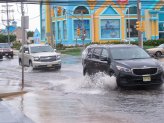Coastal communities, from the Jersey Shore to Miami to Southern California, are likely to see a dramatic surge in high-tide floods starting in the mid 2030s as rising sea levels due to climate change align with natural shifts in the moon's orbit, a new NASA study warns.
High-tide floods, also known as nuisance floods or sunny day floods, occur not because of storm surges from extreme weather or excessive precipitation, but instead when the tide rises into populated areas. The floods can overwhelm storm drains, close roads and compromise infrastructure over time.
These types of floods are already well-known to residents in places like Stone Harbor, New Jersey, or Miami, Florida, and the new study shows that sunny day flooding will grow in frequency in the mid-2030s.
David Velinsky, the vice president for science at the Academy of Natural Sciences of Drexel University who has studied the effects of rising sea levels on coastal marshes in New Jersey and Delaware, said the new study is concerning for coastal communities.
Get Philly local news, weather forecasts, sports and entertainment stories to your inbox. Sign up for NBC Philadelphia newsletters.
"Sea level rise will continue more and more, and we’ll lose more marshes. The coastal forests will be impacted, and we’re see these changes occur in the decades ahead," said Velinsky, who is also head of Drexel's Department of Biodiversity, Earth and Environmental Sciences. "And the question is how will we deal with it? How will coastal areas deal with it?"
Velinsky said the study was enlightening because it closely examined historical data at 89 locations in every U.S. coastal state, except Alaska.
"Planning, adaptation and even environmental justice issues should have started years ago," he added.
High tide floods are less dramatic visually and involve less water than hurricane storm surges, so they are often seen as a less pressing problem.
“But if it floods 10 or 15 times a month, a business can’t keep operating with its parking lot underwater," Phil Thompson, an assistant professor at the University of Hawaii and the lead author of the NASA study, said. "People lose their jobs because they can’t get to work. Seeping cesspools become a public health issue.”

The extreme tide flooding forecast in the new study is due to a so-called "wobble" in the moon's orbit. The wobble occurs on an 18.6-year cycle, and is entirely natural, first discovered in 1728.
But the new development of rising sea levels, as the global temperature warms due to human-induced climate change, amplifies one of the effects of the wobble.
The moon's gravitational pull is the cause of everyday high and low tides. But the Earth's regular high and low tides change with the moon's wobble.
For the first half of the nearly 19-year cycle, the tides are suppressed: high tides are lower, and low tides are higher. In the other half of the cycle, tides are amplified, with higher high tides and lower low tides.

High sea levels push all high tides higher, so when the next 18.6-year moon wobble cycle amplifies high tides, they will regularly top flooding thresholds.
As a result, high tides will exceed known flooding thresholds around the country more often.
The floods will also occur in clusters, which could last a month or longer at a time depending on the position of the moon, sun, and Earth, NASA said.
As the moon and Earth line up with each other and the sun in specific ways, some city dwellers could see flooding every day or two.
Ben Hamlington, a co-author of the moon wobble study and leader of NASA's Sea Level Change Team, said the study is vital for coastal urban planners, who may tend to focus on preparing for extreme weather events over chronic flooding.
“From a planning perspective, it’s important to know when we’ll see an increase,” Hamlington said. “Understanding that all your events are clustered in a particular month, or you might have more severe flooding in the second half of a year than the first – that’s useful information.”
The moon is currently in the tide-amplifying part of its 18.6-year wobble, in 2021. But most U.S. coastlines have not yet seen enough sea-level rise to notice the flooding effects.
By the mid-2030s, the next time the wobble enters its tide-amplifying phase, global sea level rise due to climate change will have had another decade to advance.
The problem will occur around the U.S., not just on one coast or the other, with "a leap in flood numbers on almost all U.S. mainland coastlines, Hawaii, and Guam."
Far northern coastlines, such as Alaska's, "will be spared for another decade or longer because these land areas are rising due to long-term geological processes," NASA said.
The study projected results out to 2080 by mapping "NOAA’s widely used sea level rise scenarios and flooding thresholds, the number of times those thresholds have been exceeded annually, astronomical cycles, and statistical representations of other processes, such as El Niño events, that are known to affect tides."
NASA's sea level portal will be updated with the results of the study as a resource for decision-makers and the public.
Velinsky, the Drexel scientist who teaches an oceanography class, said he will incorporate the moon "wobble" effect going forward.
"I’m going to include it the next time because it’s going to have a global impact," he said.



